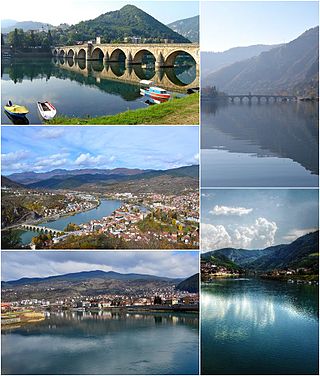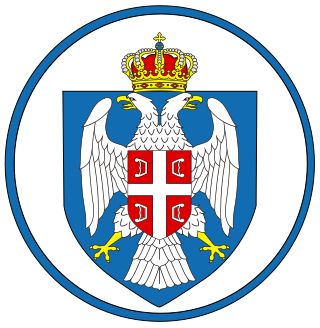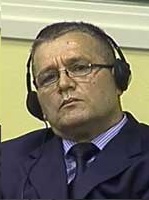
Vilina Vlas was a rape camp active during the Bosnian War. It served as one of the main detention facilities where Bosniak civilian prisoners were beaten, tortured and murdered and women were raped by prison guards during the Višegrad massacres in the Bosnian War of the 1990s. It is located about four kilometers north-east of Višegrad, in the village of Višegradska Banja.

Višegrad is a town and municipality in Republika Srpska, Bosnia and Herzegovina. It rests at the confluence of the Drina and the Rzav river. As of 2013, the municipality has a population of 10,668 inhabitants, while the town of Višegrad has a population of 5,869 inhabitants.
The Omarska camp was a concentration camp run by the Army of Republika Srpska in the mining town of Omarska, near Prijedor in northern Bosnia and Herzegovina, set up for Bosniak and Bosnian Croat prisoners during the Prijedor ethnic cleansing. Functioning in the first months of the Bosnian War in 1992, it was one of 677 alleged detention centers and camps set up throughout Bosnia and Herzegovina during the war. While nominally an "investigation center" or "assembly point" for members of the Bosniak and Croatian population, Human Rights Watch classified Omarska as a concentration camp.

Manjača was a concentration camp which was located on mount Manjača near the city of Banja Luka in northern Bosnia and Herzegovina during the Bosnian War and the Croatian War of Independence from 1991 to 1995. The camp was founded by the Yugoslav People's Army (JNA) and authorities of the Republika Srpska (RS) and was used to collect and confine thousands of male prisoners of Bosniak and Croat nationalities.
Mitar Vasiljević was a Bosnian Serb who was convicted of crimes against humanity and violation of the laws or customs of war by the International Criminal Tribunal for the Former Yugoslavia (ICTY) for his actions in the Višegrad region during the Bosnian War. He was a member of Milan Lukić's White Eagles paramilitary group.

The Heliodrom camp or Heliodrom prison was a detention camp that operated between September 1992 and April 1994. It was run by the Military Police of the Croatian Republic of Herzeg-Bosnia to detain Bosniaks, Serbs, and other non-Croats and was located at a former military facility of the JNA in Rodoč, south of the town of Mostar.

The Čelebići camp was a prison camp run by joint Bosniak and Bosnian Croat forces during the Bosnian War where Serb prisoners were detained and subjected to murder, beatings, torture, sexual assaults and otherwise cruel and inhumane treatment. The facility was used by several units of the Bosnian Ministry of the Interior (MUP), Croatian Defence Council (HVO) and later the Bosnian Territorial Defence Forces (TO). It was located in Čelebići, a village in the central Bosnian municipality of Konjic.

Milan Lukić is a Bosnian Serb war criminal who led the White Eagles paramilitary group during the Bosnian War. He was found guilty by the International Criminal Tribunal for the Former Yugoslavia (ICTY) in July 2009 of crimes against humanity and violations of war customs committed in the Višegrad municipality of Bosnia and Herzegovina during the Bosnian war and sentenced to life in prison.
Hazim Delić is a Bosnian former prison camp commander who served as the deputy commander of the Čelebići camp, a joint Bosniak and Bosnian Croat forces run prison camp, during the Bosnian War. The majority of the prisoners who were detained in the camp were men, captured during and after the military operations at Bradina and Donje Selo and their surrounding areas.

The Višegrad massacres were acts of mass murder committed against the Bosniak civilian population of the town and municipality of Višegrad during the ethnic cleansing of eastern Bosnia by Republika Srpska police and military forces during the spring and summer of 1992, at the start of the Bosnian War.

The White Eagles, also known as the Avengers, were a Serbian paramilitary group associated with the Serbian National Renewal (SNO) and the Serbian Radical Party (SRS). The White Eagles fought in Croatia and Bosnia and Herzegovina during the Yugoslav Wars.
The Velepromet camp was a detention facility established in the final days of the Battle of Vukovar during the Croatian War of Independence. The camp was set up by the Yugoslav People's Army (JNA), which shared control of the facility with Croatian Serb rebels. The facility, originally an industrial storage site, was located on the southern outskirts of the city of Vukovar, in close proximity to the JNA barracks. It consisted of eight warehouses surrounded by a wire fence, and was established on 16 November 1991, when the first detainees were brought there.
The Paklenik massacre is the massacre of at least 50 Bosniaks by the Army of the Republika Srpska in the Rogatica Municipality on 15 June, 1992.
The Sjeverin massacre was the massacre on 22 October 1992 of 16 Bosniak citizens of Serbia from the village of Sjeverin who had been abducted from a bus in the village of Mioče, in Bosnia. The abductees were taken to the Vilina Vlas hotel in Višegrad where they were tortured before being taken to the Drina River and executed. Members of a Serbian paramilitary unit commanded by Milan Lukić were convicted of the crime in 2002.
The Pionirska Street fire was an arson fire perpetrated by Bosnian Serb forces in Višegrad, eastern Bosnia, on 14 June 1992 in which 59 Bosniak women, children and elderly people were murdered by being locked into one room of a house, which was then set on fire.
The Bikavac fire refers to the arson perpetrated in Bikavac, near Višegrad, eastern Bosnia, on 27 June 1992 in which at least 60 Bosniak civilians, mostly women and children, were burned alive after the Serb forces captured them in the house which was set on fire.
Bakira Hasečić is a Bosnian human rights activist who advocates for the rights of women who were raped during the Bosnian War.

Sredoje Lukić is a Bosnian Serb war criminal.
Branimir Savović is the former president of the Serbian Democratic Party (SDS) for the municipality of Višegrad in eastern Bosnia and Herzegovina at the time of the outbreak of the Bosnian War 1992-1995. He was appointed to the Presidency of the Municipality by the Bosnian Serb authorities and became President of the "Crisis Staff Committee" established to assume responsibility for the civilian administration of the town. It was during his presidency of the Crisis Staff that the Višegrad massacres took place and the campaign of terror conducted by Milan Lukić and his White Eagles gang proceeded unchecked until Višegrad was purged of its entire Bosniak population. Višegrad has been described as second only to Srebrenica as a byword for ethnic cleansing and for humanity at its cruellest.
Esad Landžo is a Bosnian convicted war criminal and former camp guard at the Čelebići camp during the Bosnian War. He served under this capacity from the camp's establishment until it ceased operations, between May 1992 and December 1992, under the command of the camp's deputy commander Hazim Delić and commander Zdravko Mucić. As a guard, Landžo beat, tortured and murdered Serb prisoners.










